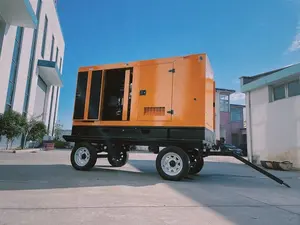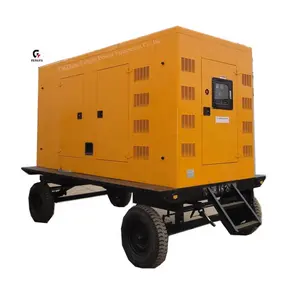(2865 products available)







































































































































































































Electrostatic generators are also called static electricity generators, and they all produce high voltage and low current by electrostatic induction. They form a thin layer of charges on the surface of the conductors by continuously passing charge carriers through them. Systems can be manual or automatic, and they have different charging methods based on their design. Here are the most common types of electrostatic generators found on Alibaba.com:
Van de Graaff Generator
This type of electrostatic generator, named after one of its inventors, is the most famous. It usually consists of a large metal dome held at a high voltage with a belt moving charge to or from it. The belt is designed to remove or deposit charges on the dome, depending on whether a positive or negative charge is desired. A terminal connected to the dome is held at the voltage of the dome, where a thin stream of sparks can be seen. In industrial applications, these generators are used in X-ray machines and cancer treatment machines.
Influence Machine
The influence machine is another type of electrostatic generator made from four charged glass or plastic plates with metal coatings on one side. Two of these plates attract and hold the charges, while the other two store the charges without losing balance. This machine was meant to be a better option for earlier generators, which required a lot of mechanical energy to operate. It is also called an electrostatic machine.
Devil's Footprints
This generator is simple and consists of two metal spheres connected with a metal rod, usually zinc. It produces a high voltage through a series of processes, including induction, in which charge carriers are separated in one sphere while the other is connected to the ground. Due to its simple construction, it is mostly used in schools and educational institutions for demonstrational purposes. While small, the Devil's footprints generator makes a great static electricity science project for the classroom.
Crown Glass Generator
This is one of the earliest known electrostatic generators, discovered in about 1600. It consists of a glass piece wrapped into a cylindrical wheel that produces static electricity when the wheel is turned. This is achieved through friction between the glass and the operator's hand, where the glass surface becomes electrostatically charged and collected upon rotation. The negative charges are attached to the glass while positive charges are displaced from the glass. The friction wheel generator is still used today in different designs and variations to produce static electricity, especially in high-voltage experiments.
Electrostatic Precipitators
These are used to remove hazardous pollutants from industrial emissions. They remove particulate matter from air or gases using induced static electricity to charge particles and trap them on collection plates. These generators are especially important for industries dealing with large air or gas emissions like power generation, steel and cement manufacturing, oil refining and petrochemicals, and mining and mineral processing, where heavy dust poses health and environmental issues.
Pulp and Paper Industry
Paper experience generators help with pulp drying by charging and polarizing wood and vegetable fibers. This improves the retention and uniformity of water during pulp processing. This reduces drying time, leading to lower energy costs and better final product quality. Generators also help coat fibers with electrostatically charged chemicals to improve fiber processing.
Textile and Coating Industry
Generators are used in coating processes to ensure even coating application and reduce paint or coating waste. In textiles, they aid in the deposition of electrostatically charged fibers or dyes for improved adherence. This is especially useful in automobile and furniture upholstery, where coating and dye application uniformity directly affects quality. In other sectors, better electrostatic generators increase efficiency while lowering operational costs.
Plastics Industry
Charged plastic particles are sprayed in an electric field to produce an even distribution for optimum surface area in processes like nucleation, polymerization, and emulsification in chemical production. This is practical in pharmaceutical manufacturing and chemical industries, where better product quality and more efficient processes are desired.
Type of generator
The main types of electrostatic generators are Van de Graaff, the influence machine, and friction. Knowing the different generator types allows standing buyers to source the right option for their specific static electricity-related applications. Business buyers should also consider whether they want manual or automatic, because this would affect the overall ease of use.
Output voltage and durability
Generators can produce various voltage levels, and higher voltages are generally better for advanced applications. Battery-operated machines may not produce as much current, but they are portable and convenient. Manual machines, meanwhile, require more effort but might be more durable with fewer electronic components. Seeking generators with robust build materials will ensure the machines last longer, especially if they will be used frequently.
Size and mobility
Depending on the intended usage, one might prefer a small portable electrostatic generator or one large enough to handle intense applications. Larger generators typically provide more output, but they are not easy to relocate. On the other hand, compact models are more convenient and can be easily moved from one area to another. Weight contributes to mobility, so it's important to assess this, too.
Safety mechanism
Various datasets should be used to assess the safety features of the electrostatic generators. For instance, grounding features or discharging rods help mitigate the chances of dangerous sparks leading to fires and damage. Furthermore, emergency halt mechanisms can guarantee peace of mind while operating the electrostatic generators. Buyers intending to use the equipment in hazardous environments should prioritize machines with enhanced safety precautions.
Usage/application
What will the generator be used for? Different generators are used for different applications, so one must consider the intended usage as they choose. For example, some generators might be better suited for scientific investigations that require high voltage and fine control, while others might be practically used in school laboratories or industrial electrostatic precipitators.
Regular cleaning
Accumulated dirt or debris may interfere with the performance of an electrostatic generator, so keeping it clean is important. Cleaning should be done using a damp cloth and mild cleaning detergent, and abrasive scrubs shouldn't be used so the surface doesn't scratch and lose its electrostatic charge. In schools and places where the generators aren't moved around often, daily cleaning is advisable because dust can settle on them and affect their functionality. For piece of electrostatic machinery used in production and industrial areas, cleaning should be done at least once every week or after every workday to avoid damage to the components and ensure optimum generation capability.
Regular checks for wear and tear
Cabinets, insulators, brushes, and belts are among the most common parts of electrostatic generators that wear or tear over time. It is important to check for visible damage, cracks, or warping regularly to ensure good performance. The assisters should also check for abnormal noises and vibrations because this could indicate something is wrong somewhere. In electrostatic machines used in industries, one should also ensure no loose wires or connections are present, as this can sometimes lead to unwanted sparks or other hazards. While performing visual inspections, users should also shut down the electrostatic generators so as to eliminate any chances of accidental electrostatic discharges. More thorough inspections are best done when the machine is not in use or during scheduled downtimes. In case of abnormal signs such as wearing and tearing, they should be replaced as soon as possible, and reputable manufacturers's recommendations for replacement parts should be followed.
Lubrication and storage
Improper lubricating working parts can hasten wear and tear, so it is important to determine where to lubricate and do it often. Also, one should store the generator appropriately when it's not in use, especially when the storage period will be prolonged. In this case, cover the generator using an appropriate cover to prevent dust accumulation, as it might cause the generator to malfunction.
Here are some frequently asked questions business owners asking about electrostatic generators:
Q1: How do electrostatic charges work?
A1: Electrostatic charges are produced by transferring electrons between surfaces through materials that are in contact with each other. Examples of these materials include rubbing a balloon on hair, where the balloon attracts the hair, resulting in a balloon with negative static charge repelling the hair with the same static charge. Other means of generating electrostatic charges include using an electrostatic generator machine and providing insulation.
Q2: How much does one electrostatic generator cost?
A2: Various factors affect the generator cost, including voltage output, generator size, brand, and model. In addition, specific application requirements and day-to-day operational costs should also be considered, as they affect long-term performance. Cost-effectiveness is especially important when the machines will be used for an extended period of time, as they will likely be a recurring cost to maintain and operate.
Q3: Can an electrostatic generator produce more than one million volts?
A3: Yes, certain generators like the Van de Graaff generator can produce up to 15 million volts in laboratory conditions. However, such a high voltage level isn't usually risky. An electrostatic shock of over 100,000 volts can be fatal, so it is not viable to under-handle such voltages. It is important to remember that an electrostatic generator creates an electric field, and too much electric field intensity can lead to electrical discharges like sparks. These discharges can cause physical injury and fires, for example. In case an electrostatic generator produces a large voltage number, it must be equipped with enhanced safety measures and procedures to take in the event of ungrounded or improper discharge.
Q4: When was electrostatics discovered?
A4: Gregor Johann Mendel, a Czech monk, discovered the principles of electrostatic charge in 1860. In 2004, Van de Graaff produced its first electrostatic generator, which was used for nuclear research and offered scientists and researchers voltages of up to 15 million.